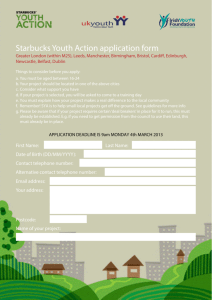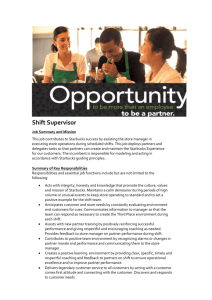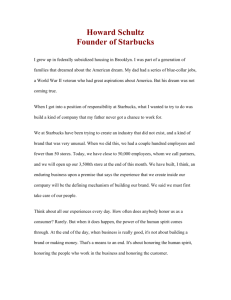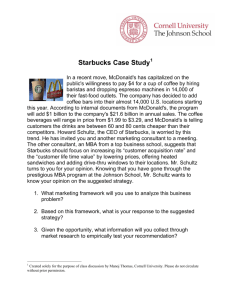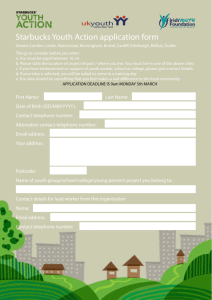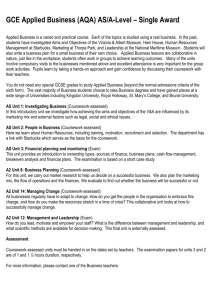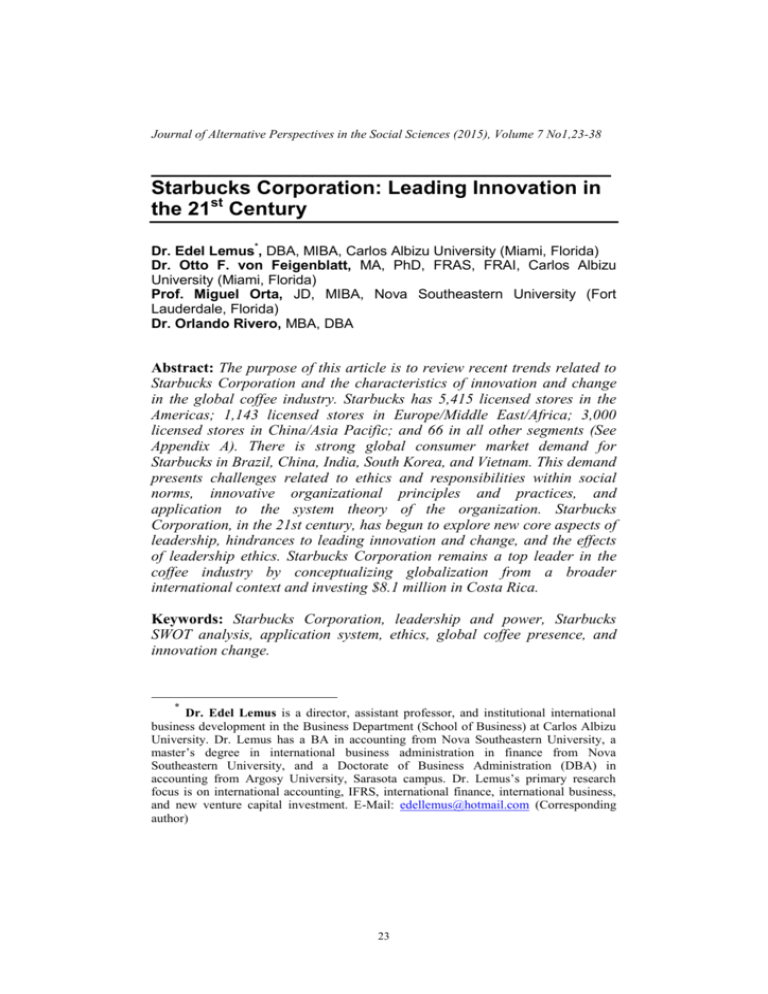
Journal of Alternative Perspectives in the Social Sciences (2015), Volume 7 No1,23-38
________________________________________
Starbucks Corporation: Leading Innovation in
the 21st Century
Dr. Edel Lemus*, DBA, MIBA, Carlos Albizu University (Miami, Florida)
Dr. Otto F. von Feigenblatt, MA, PhD, FRAS, FRAI, Carlos Albizu
University (Miami, Florida)
Prof. Miguel Orta, JD, MIBA, Nova Southeastern University (Fort
Lauderdale, Florida)
Dr. Orlando Rivero, MBA, DBA
Abstract: The purpose of this article is to review recent trends related to
Starbucks Corporation and the characteristics of innovation and change
in the global coffee industry. Starbucks has 5,415 licensed stores in the
Americas; 1,143 licensed stores in Europe/Middle East/Africa; 3,000
licensed stores in China/Asia Pacific; and 66 in all other segments (See
Appendix A). There is strong global consumer market demand for
Starbucks in Brazil, China, India, South Korea, and Vietnam. This demand
presents challenges related to ethics and responsibilities within social
norms, innovative organizational principles and practices, and
application to the system theory of the organization. Starbucks
Corporation, in the 21st century, has begun to explore new core aspects of
leadership, hindrances to leading innovation and change, and the effects
of leadership ethics. Starbucks Corporation remains a top leader in the
coffee industry by conceptualizing globalization from a broader
international context and investing $8.1 million in Costa Rica.
Keywords: Starbucks Corporation, leadership and power, Starbucks
SWOT analysis, application system, ethics, global coffee presence, and
innovation change.
*
Dr. Edel Lemus is a director, assistant professor, and institutional international
business development in the Business Department (School of Business) at Carlos Albizu
University. Dr. Lemus has a BA in accounting from Nova Southeastern University, a
master’s degree in international business administration in finance from Nova
Southeastern University, and a Doctorate of Business Administration (DBA) in
accounting from Argosy University, Sarasota campus. Dr. Lemus’s primary research
focus is on international accounting, IFRS, international finance, international business,
and new venture capital investment. E-Mail: edellemus@hotmail.com (Corresponding
author)
23
Lemus, von Feigenblatt, Orta, & Riviero
1. Introduction
Starbucks Corporation Background
The Starbucks brand originated in 1971 by opening its
first store location in Seattle, Washington. In the 1970s and
1980s, Starbucks Corporation experienced success in the
U.S. market. By 1987, Howard Schultz purchased Starbucks
after serving for 5 years in the operation department at
Starbucks Corporation. By the end of the year 2000, Schultz
had increased from 17 coffee shop to the number of coffee
shop to 4,000. Moreover, until the year 2000 Schultz
assumed the responsibility as CEO, chairman, and chief
global strategist. As soon as Schultz took command of
Starbucks Corporation the company was driven in a new
avenue in the coffee market. Schultz moved Starbucks
Corporation into a new golden business era not just locally
but internationally (Loyd, Jackson, & Gaulden, 2001).
Starbucks Corporation History
In 1971, Starbucks Corporation was founded by Gordon
Bowker, Jerry Baldwin, and Zev Siegl in Seattle, Washington.
In 1972, driven by the success of the first store, they opened
a second store in University Village, Washington. Starbucks
began selling and distributing coffee at wholesale
businesses. Within the next decade, leaders made the
decision for Howard Schultz to purchase the company and
manage the sales of the retail stores as well as to support the
marketing campaign. Starbucks Corporation began to
experience the spirit of success that was present when the
organization was established in 1971 (David, 2013).
By 1993, Starbucks expanded its horizons by entering
into a business venture with Barnes and Noble on the East
Coast of Washington. The goal was to sell Starbucks coffee in
bookstores where people came to spend quality time reading
books. At that time, Starbucks Corporation had licensed 12
stores and was operating 260 company owned facilities with
revenues of $176.5 million and reaching net earnings of $8.3
million. Furthermore, in the year 2000, leaders at Starbucks
24
Starbucks Corporation: Leading Innovation in the 21 st Century
Corporation decided to expand the business concept out of
the United States by opening a total of 200 new store
locations. As soon as the concept was introduced overseas,
150 new stores were opened in the Asia-Pacific region by
opening the first stores in Dubai and Hong Kong, and the
remaining population of stores in both Japan and the United
Kingdom. Starbucks Corporation found a unique market
niche in continental Europe by opening the first store in
Zurich, Switzerland. A new historical precedent marked an
important position for Starbucks Corporation securing more
holding value in the coffee industry (David, 2013).
Starbucks Corporation, in 2002, encountered its first
major loss (i.e., $3.9 million) in the market from its Japanese
operation expansion. This loss did not discourage leaders
from continuing to foster new opportunities in the market.
As a result, Starbucks Corporation opened its first store in
Turkey and as a strategic alliance acquired 129 Seattle’s
Best Coffee houses. Moreover, by 2004, Starbucks
Corporation announced plans to open 15,000 new stores
domestically and 30,000 internationally. By 2007, the
economic recession hit the Anglo-Saxon market and along
with the economic recession McDonald’s entered into the
coffee business. However, the economic recession forced
Starbucks Corporation to close 600 stores because of bad
performance in the U.S. market. In 2009, Starbucks
Corporation began a new business venture by opening 200
new stores and launched the new Starbucks card iPhone
app to attract more customers, as well as opened new stores
in Aruba, Poland, and East Africa. By 2010, Starbucks
expanded its digital network to provide unlimited Wi-Fi and
reinvested in the company’s brand name by expanding its
line of business to El Salvador, Hungary, and Sweden. By
2011,
Starbucks
Corporation
celebrated
its
40th
anniversary, supporting the outreach of the global
community by opening new stores in Guatemala. The total
number of stores that Starbucks Corporation had in place as
of 2012 was 17,651 (David, 2013) in the following countries:
Argentina, Aruba, Australia, Austria, Bahamas,
Bahrain, Belgium, Brazil, Bulgaria, Canada, Chile,
China, Costa Rica, Curacao, Cyprus, Czech Republic,
25
Lemus, von Feigenblatt, Orta, & Riviero
Denmark, Egypt, El Salvador, England, Finland,
France,
Germany,
Greece,
Guatemala,
Hong
Kong/Macau, Hungary, Indonesia, Ireland, Japan,
Jordan, Kuwait, Lebanon, Malaysia, Mexico, Morocco,
New Zealand, Netherlands, Northern Ireland, Oman,
Peru, Philippines, Poland, Portugal, Qatar, Romania,
Russia, Saudi Arabia, Scotland, Singapore, South
Korea, Spain, Sweden, Switzerland, Taiwan, Thailand,
Turkey, United Arab Emirates, United States and
Wales. (p. 1)
Starbucks Corporation Leadership and Power
In 1987, after Howard Schultz purchased Starbucks
Corporation he became the new CEO and Chairman. In
addition, Schultz had the innovative idea in 1987 to open
125 new stores in the market and deliver high results to
investors in the company. Schultz decided to keep the official
brand name as Starbucks for competition purposes only,
because the brand name already had recognition in the
market. According to Schultz, having a name people could
remember and recognize . . . and relate to provides
enormous equity” (Loyd et al., 2001, p. 42). The effort of the
Starbucks management team was to continue opening more
local stores as they had initially planned and to expand their
service forces globally by opening more than 4,000 new store
locations worldwide. Schultz’s vision and mission leadership
guidance were to encourage employees and investors to drive
Starbucks in a healthy financial avenue and to continue
growing its venture capital investment overseas (Loyd et al.,
2001).
Schultz was successful as an entrepreneur but had to
admit his limitations of skills in the new business era in
which Starbucks Corporation was embarking. In addition,
senior management at Starbucks had decided that Schultz
should step down because Starbucks grew so fast that it
quickly became a global company and needed to be managed
from an entrepreneurial perspective. Schultz knew that
senior management could drive Starbucks toward a safe
operational and financial position in the market. Senior
management and Schultz worked together to locate
26
Starbucks Corporation: Leading Innovation in the 21 st Century
professionals who would be suited to adequately manage and
deliver the outcomes of Starbucks Corporation in the global
arena. For example, the management team was driven from
an entrepreneurial avenue to deliver results. By 2000, Orin
Smith became the new CEO of Starbucks and was hired to
turn around the business horizons of the organization.
Smith recruited seasoned professionals in specific areas in
the company such as finance, legal, supply-chain operations,
and management information systems. Smith brought a
transformational leadership style to Starbucks Corporation
by keeping a clear path of the company’s direction, following
the vision and mission statement of Starbucks Corporation,
and serving as a role model in the organization (Loyd et al.,
2001).
Social media is a valuable tool for Starbucks Corporation
because it drives the sustainability of the company’s brand.
In addition, integrating the team management as part of the
cultural aspect of the organization is key because it helps
solidify the business transition in the market. Chua and
Banerjee (2013) determined three major innovative steps
that Starbucks had implemented over the years: (a)
deploying social media to effectively support the branding
and marketing position of the product, (b) understanding the
role of a new channel to use the social media, and (c) relying
on effective strategies to protect consumers’ engagement with
the products (Chua & Banerjee, 2013).
The evolution of corporate social responsibility (CSR) was
one avenue of innovation for Starbucks Corporation in that it
helps to protect both the brand image and the environment.
Additionally, CSR has given Starbucks Corporation a new
position in the market by demonstrating a balance among
economic prosperity, social integrity, and environmental
responsibility. Starbucks Corporation has proven through
CSR that its long-term commitment and projects can be
sustainable and achievable (Katrinli, Gunay, & Biresselioglu,
2011).
Marques (2008) reported that in the Fortune 100 Best
Companies to work for in 2007, Starbucks Corporation was
listed as number 16 because it had implemented spirituality
27
Lemus, von Feigenblatt, Orta, & Riviero
in the workplace as an innovative approach to enrich the
ethical values of management and employees. Five factors
come along with the implementation of spirituality at work:
(a) leadership position in the market, (b) financial
sustainability of the organization, (c) work environment, (d)
commitment to innovation, and (e) meeting CSR
requirements. Shareholders at Starbucks Corporation
concluded that spirituality at work helped Starbucks to
increase work productivity and employees’ motivation levels
to strive for excellence (Marques, 2008).
The rationale for the expansion of Starbucks was to
enable the company to increase the position of its products
in different markets around the globe. In addition, opening
new stores set a leading path for Starbucks in the market
because the company was specializing in success and
continued to have positive effects among its competitors.
Moreover, Starbucks holds strong values related to the
sustainability of employees, coffee farmers, and coffee
growing practices. The supply chain of the company’s
retailing venture has created new partner efforts. The
Starbucks philosophy is to engage employees and
management at all levels within the organization. Starbucks
continues to grow rapidly and expand the frontiers of the
company’s vision and mission (Koehn, Besharov, & Miller,
2008).
Starbucks receives strong financial support from its
stockholders. After 1992, Starbucks went public by creating
a new perception of business value. Koehn et al. (2008)
revealed in their study that Starbucks was able to finance its
international expansion by building a solid presence in the
stock market. Furthermore, historical sales have provided a
great appreciation to the company’s stock price. In 2000,
Starbucks funded the company’s expansion into the
international arena by utilizing at full capacity the funds
from the Statement of Cash Flows rather than financing the
operations through external sources (Koehn et al., 2008).
The international expansion relied on new products and
services to drive future growth. In addition, Starbucks was
able to engage innovative avenues by introducing its
products into grocery stores, warehouse clubs, and retail
28
Starbucks Corporation: Leading Innovation in the 21 st Century
outlets to increase public awareness. Starbucks saw the
opportunity to offer classical music, books, and movies.
However, Starbucks had a broader objective of what the
company would become in the near future. The product
expansion also provided a source of incremental revenue
that would help the company to continue to meet investors’
growth expectations. Starbucks brought a transformation of
the new business era to the coffee industry (Koehn et al.,
2008).
The importance of creativity to Starbucks is to focus on
individuals, the organization, and creating new ways of
thinking in the global coffee industry. Creativity refers to
organizing an idea based on its impact on the organization’s
goals and objectives. Moreover, Starbucks ensures that
organizational success is met by increasing the quality of its
products and constantly committing to new challenges with
competitors and employees. Starbucks defines creativity in
the organization by applying the three components of
expertise, motivation, and new way of thinking. The first
component of the creativity level is individual expertise that
consists of combining work-related procedures and product
expectations. The second component of the creativity level is
motivation that drives the passion of the organization to be
creative about the company brand name. The third
component of creativity is new ways of thinking; that is, the
capacity to put into place new ideas to determine the
flexibility and approach to the problem. Therefore, the
innovation creativity of Starbucks brand can fuel the
company’s prosperity and promote the company’s product
development process (Certo & Certo, 2012).
2. Starbucks SWOT Analysis – Creativity
Starbucks Corporation is known as a roaster, marketer
and retailer of specialty coffee. Starbucks Corporation has
set a retail footprint in the global coffee retail industry. In
emerging economies market such as Brazil, Russia, India
and China has expanded new stores by acquiring local
companies. As indicated by Canadean Company Reports
(2014) “However, higher commodity costs, intense
29
Lemus, von Feigenblatt, Orta, & Riviero
competition, and legal proceedings could have an adverse
impact over the business, operating results and financial
condition of the company” (p.31).
Internal
Strengths
Established 40 years in the
market
Adequate financial sustainability
Company’s culture contribution
Ethical for best business practice
Experience in the market
Top brand leader in the market
Largest chain of coffee farm
houses around the world
Worldwide partners
Strong management guidance
Longstanding efforts to balance
profits with CSR
Weaknesses
High price of coffee beans in the
market
Brand criticism
Product price
Standardizing of work processes
External
Opportunities
Threats
Starbucks has stores in 50
Starbucks cannot control the
countries with 5,500 coffeehouses
price of coffee beans
Synchronization of supply chain
Trademark violations
coordination in the market
Capture economies of scale in
the emerging economies market
New venture capital expansion
investment in the emerging
Seeking opportunity market
economies market
niche in developing economies
Setup of worldwide retail
Economic, political, social,
operations
legal, financial, and weather
Improving farmers’ access to
climate risks will add cost to the
carbon markets
supply chain distribution
channel
Provide opportunities to
employees to study
Business model development is
based on diversity and team
guidance
Starbucks SWOT Analysis – Leadership
30
Starbucks Corporation: Leading Innovation in the 21 st Century
Internal
Strengths
Starbucks possesses
flexibility and innovation
Building knowledge by
facilitating individual and
team learning experience
Sharing knowledge and
ideas
Demonstrates optimism and
commitment in the market
Communicates a clear vision
through a business plan
Values organization change
Supports the mission and
vision statement of the
company
Continually audits the vision
statement
Solid organization structure
External
Opportunities
Extend opportunities to
talented individuals
Empower competent
individuals to support the
planned implementation
change
Use task goals and
objectives to guide the team
assignment implementation
Design its own management
implementation plan system
Employee retention is a top
priority
Organization values
Support organization change
Weaknesses
Emphasize criticism of the
mission and vision
statement
Lack of long-term
production results
Management has to learn
how to be modest
Capital investment wellbeing
Threats
Expansion of strategic
objectives
Organize team activities
Encourage mutual trust
among competitors
Analyze cautiously
competitive environment,
political processes, and
emerging problems
3. Starbucks Corporation Creativity
31
Lemus, von Feigenblatt, Orta, & Riviero
Creativity is not just selling an idea and is more than the
innovation of new ideas. As illustrated in the first portion of
the SWOT analysis, innovation requires flexibility and new
ways to successfully address and overcome new problems in
the industry. Starbucks continues expanding its new
business venture capital investment; investors want to
understand consumer behaviors. Furthermore, Starbucks
has been successful in the market through being able to
balance between the flexibility and rigidity of the
organization. Therefore, the SWOT analysis serves as both
an internal and external tool to evaluate alternative
strategies by allocating resources effectively and efficiently
(Osland & Turner, 2011).
Osland and Turner (2011) argued that conducting
adequate research and development in the market will lead
to gaining a competitive position. The decisions surrounding
designing new stores are quite innovative and represent a
new consumer class. The way Starbucks treats innovation is
by following procedures and product lines with teams that
are expected to meet the demand in the local and global
market arenas (Osland & Turner, 2011).
4. Application of the System
The application system of Starbucks Corporation is to
successfully add a brand, because a brand creates the
foundation for sustainable financial assets in an
organization (See Appendix B). In addition, brand equity is
considered a key factor in the application system of
Starbucks because it creates the value of marketing and
business strategy in the market (Doyle, 1998). Czinkota,
Ronkainen, Moffett, and Moynihan (1998) emphasized that a
company’s brand name helps to distinguish the company’s
image among competitors in the market. Zhenjia (2012)
indicated that a successful brand can help a company
achieve a good reputation in the market. The majority of
consumers around the globe are familiar with and know the
quality service provided by Starbucks Corporation.
Therefore, throughout the application system process,
Starbucks has a positive brand name, which influences the
32
Starbucks Corporation: Leading Innovation in the 21 st Century
decision-making process surrounding building customer
loyalty (Zhenjia, 2012).
The application system process of supporting employees
and customers plays an essential role, because as Hoffman
and Bateson (2002) indicated, service personnel will dictate
the product differentiation among existing competitors in the
market. In addition, Starbucks faces a tremendous challenge
in promoting the organizational value of the company as it
expands. Starbucks treats customers in a friendly manner
and makes them feel at home, and treats employees as
partners which ultimately is a great approach because
employees feel they are valued assets. The main philosophy
in the Starbucks application system process is to provide
knowledge about the company’s culture, service skills, and
self-training development. Throughout the years Starbucks
has shown a consistent pattern in re-engineering the vision
and mission statement of the company (Zhenjia, 2012).
Starbucks has created a positive relationship between job
satisfaction and customer satisfaction (Kotler et al., 1999). In
addition, the management team at Starbucks believes that
employees can expand their knowledge and at the same time
satisfy the organization by offering great quality customer
service. Starbucks provides training to employees because
management believes in human capital development within
the organization’s expectations. For example, one of the most
appropriate training techniques within Starbucks is that
employees help the customers select a specific product based
on their personal taste. Therefore, Starbucks remains a top
competitor in the market by guiding staff in the proper
direction (Zhenjia, 2012).
Starbucks provides diversification of products in the
market. In addition, Starbucks customers value the
differences that exist between the company’s quality product
(Kotler, Brown, Adam, & Armstrong, 2004) as well as the
cost to obtain the same. Starbucks is committed to offering
the highest quality coffee in the market and continues to
capture a large retail opportunity by keeping fresh coffee and
an updated selling position, and enhancing the customer
experience by designing creative and original store concepts.
33
Lemus, von Feigenblatt, Orta, & Riviero
Throughout the years Starbucks has provided legendary
customer service. Innovation and the product (Doyle, 1998)
are the keys to Starbucks strategic application process to
succeed in the market. For example, another innovative
channel of the company is the strategic position of
expanding the food offerings in coffee shops, new coffees,
and continuing to inspire the brand name to do well in the
market. Therefore, the focal point of Starbucks is product
innovation (Zhenjia, 2012).
In the past decade, leadership has been one of the most
attractive topics in the business discipline. Luu (2012)
suggested that there is an existing relationship between
patterns of leadership and organizational trust and unethical
behavior. A pattern of leadership is related directly to the
transformational and transactional leadership styles. Luu
defined transformational leadership as being built solely on
trust, where unethical acts are less acceptable. Starbucks
leadership possesses a transformation leadership style
because of the belief in personal identification by influencing
the inspirational level of leader and followers’ perceptions
about the internalization of the organization aspects.
However, top corporations in the United States are
concerned
about
ethical
behavior.
Therefore,
the
organization’s cultural environment is highly reflected
through the ethical leadership behavior that supports the
vision and mission statement of an organization (Luu, 2012).
Starbucks Corporation has been able to surpass
competitors in the international market because over the
years it has perfected its international joint venture (IJV)
channels. In addition, Starbucks has been successful in
South Korea because leaders were able to engage the
organization’s cultural values with South Korean market
strategies. Moreover, the Starbucks team in South Korea
follows the company’s goals and objectives by meeting
critical demand in the market. The IJV in South Korea has
helped expand the corporate values. Starbucks has proven
in the coffee industry that organizational culture, corporate
values, and team orientation play essentials role in the
international marketplace. Therefore, Starbucks is an
organization that involves all leaders from different levels to
34
Starbucks Corporation: Leading Innovation in the 21 st Century
help create a flexible work environment (Lee, Madanoglu, &
Ko, 2013).
5. Conclusion
In conclusion, the background of Starbucks Corporation
reveals its presence in the market since 1971. Schultz
brought a transformational leadership style to Starbucks
Corporation by keeping a clear path of the company’s
direction by following the vision and mission statement and
serving as an organizational role model. Starbucks
Corporation is a solid and sustainable organization in the
global coffee market because the company strives to surpass
excellence by meeting the five factors of spirituality at work:
(a) strong leadership position in the market, (b)
organizational financial sustainability, (c) suitable work
environment, (d) innovation commitment, and (e) CSR
requirements. Throughout the years Starbucks Corporation
has shown a consistent pattern of re-engineering the
company.
The new growth platform of Starbucks Corporation is by
supporting company’s ethical values and branding
organizational demand. Starbucks is a global company that
meets the demand for innovation at a global level. As a
result, Starbucks continues to accelerate its international
presence. In essence, it continues to be one of the top
leaders in the coffee industry and a customer oriented
organization. Starbucks possesses the intellectual creativity
needed to meet the company’s goals and objectives. For
example, its successes rely on principles and practices by
surpassing challenges in the local and global markets.
Starbucks has 141 coffee shops across Malaysia and more
than 700 coffee shops around the Southeast Asian region,
including the following countries: Indonesia, the Philippines,
Singapore, Thailand, and, most recently, Vietnam.
6. Recommendation for Future Studies
The authors of this article suggest that the following
aspects be considered for future studies into the global
35
Lemus, von Feigenblatt, Orta, & Riviero
presence of Starbucks Corporation and the business world
in the international market arena:
Starbucks Corporation will need to improve the
product value creation.
Starbucks will need to reduce its liability exposure risk
related to advertisement and promotion, because in
2008 advertisement expenses were reported at $129.0
million, in 2000 were reported at $103.5 million, and
in 2006 were reported at $107.5 million (Ng, 2011).
As Starbucks continues its efforts to buy out its
Japanese local chain partner, leaders should focus on
standardizing products by acquiring new resources,
centralizing cost leadership, and reinventing the
logistics material management.
In 2017, Starbucks intends to increase the coffee
quality standard in the Brazilian and Vietnamese
markets.
7. References
Certo, C. S., & Certo, S. T. (2012). Modern managementconcepts and skills (12th ed.). Upper Saddle River, NJ:
Pearson Prentice Hall.
Chua, A. Y. K., & Banerjee, S. (2013). Customer knowledge
management via social media: The case of Starbucks.
Journal of Knowledge Management, 17(2), 237-249.
Czinkota, M. R., Ronkainen, I. A., Moffett, M. H., &
Moynihan, E. O. (1998). Global business (2nd ed.).
Orlando, FL: The Dryden Press.
David, F. (2013). Strategic management: Concepts and cases
(13th ed.). Upper Saddle River, NJ: Pearson Prentice Hall.
Doyle, P. (1998). Marketing management and strategy (2nd
ed.). London, England: Prentice Hall Europe.
Hoffman, K. D., & Bateson, J. E. G. (2002). Essentials of
services marketing: Concepts, strategies and cases (2nd
ed.). Fort Worth, TX: Harcourt College Publishers.
36
Starbucks Corporation: Leading Innovation in the 21 st Century
Katrinli, A., Gunay, G., & Biresselioglu, M. E. (2011). The
convergence of corporate social responsibility and
corporate sustainability: Starbucks Corporation’s
practises. The Business Review, Cambridge, 17(1), 164171.
Koehn, F. N., Besharov, M., & Miller, K. (2008). Starbucks
coffee company in the 21st century. Harvard Business
Review.
Kotler, D., Brown, L., Adam, S., & Armstrong, G. (2004).
Marketing (6th ed.). Frenchs Forest, NSW:
Pearson/Prentice Hall.
Kotler, P., et al. (1999). Marketing Management: An Asian
Perspective. Singapore: Prentice Hall.
Lee, K., Madanoglu, M., & Ko, J-Y. (2013). Developing a
competitive international service strategy: A case of
international joint venture in the global service industry.
The Journal of Services Marketing, 27(3), 245-255.
Loyd, S., Jackson, W. T., & Gaulden, C. (2001). Starbucks
coffee: High octane. Proceedings of the International
Academy for Case Studies, 8(2), 38-43.
Luu, T. T. (2012). The linkages among leadership, trust, and
business ethics. Social Responsibility Journal, 8(1), 133148.
Marques, J. F. (2008). Spiritual performance from an
organizational perspective: The Starbucks way. Corporate
Governance, 8(3), 248-257.
Ng, J. C. Y. (2011). Starbucks’ operations in Singapore: Oasis
in midst of desert? Montréal: HEC Montréal.
Osland, S. J., & Turner, E. M. (2011). The organizational
behavior reader (9th ed.). Upper Saddle River, NJ:
Prentice Hall.
Starbucks Corporation. (2013). Fiscal 2013 annual report.
Seattle, WA: Author. Retrieved from
37
Lemus, von Feigenblatt, Orta, & Riviero
http://investor.starbucks.com/phoenix.zhtml?c=99518&
p=irol-reportsannual
Starbucks Corporation. (2014). 2014 Form 10-K. Seattle, WA:
Author. Retrieved from
http://investor.starbucks.com/phoenix.zhtml?c=99518&
p=irol-reportsannual
Starbucks corporation : Foodservice - company profile, SWOT
& financial report. (2014). (). Basingstoke: Progressive
Digital Media.
Zhenjia, Z. (2012). Study on competitive advantages of
Starbucks surfers’ paradise coffee shop. Management
Science and Engineering, 6(3), 16-21.
38


